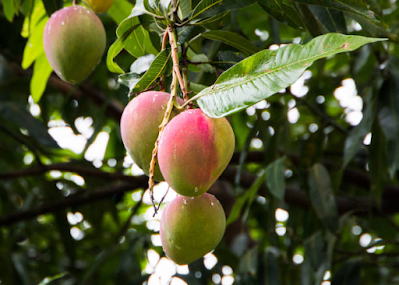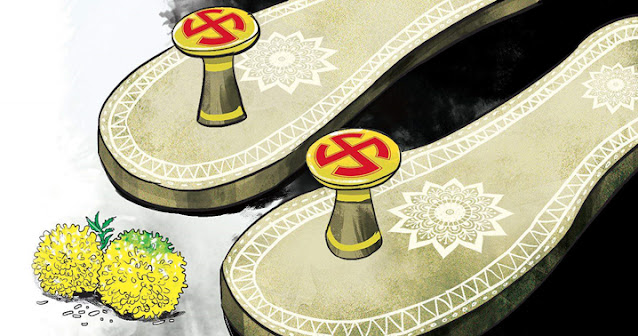The Divine Mango
It is more than a delicious fruit, for it is sacred, even a goddess
The mango or Mangifera indica is the favourite fruit of every Indian. It is believed to have originated in southern Asia, particularly in eastern India. Whether it is Alphonso or Banganapalli or Kilimookũ or any other, it is on the ‘Mango Map’ of India. There are nearly 1,500 varieties of mango in India, including about 1,000 commercial varieties. Each variety of mango has a unique taste and flavour. The king of them all, Alphonso, was the first variety to be grafted. The word mango comes from the Tamil ‘manga’, so the fruit is as Indian as you can get.
But the mango is more than a delicious fruit, for it is sacred, even a goddess. Amba or Ambika, the mango goddess, is Durga or Adi Parashakti, Mother of the Universe and of all creation. In the Skanda Purana, she kills the demons Shumbha and Nishumbha. In the Devi Bhagavatam, Ambika is the progenitor of all other goddesses. Her vehicle is a lion and she has four arms: two right hold a mango and a branch of a mango tree, while the left holds a child.
The mango tree is a kalpa-vriksha, a wish-fulfilling tree, a symbol of love, devotion, fertility and abundance. The tree is an incarnation of Prajapati. In a ceremony known as dohada, a young girl kicks the mango tree to bring it to fruition. The Sanchi stupa is decorated with beautiful vrikshakas, some holding a branch full of mangoes—young, naked, bejewelled and sensuous women, the touch of whose foot could bring the tree to fruition. The internationally renowned sculpture of the Sanchi stupa is the exquisite mango vrikshaka (also known as shalabhanjika), depicting fertility and abundance of nature. On the torana of the eastern gateway, she has been carved holding a branch of the mango tree above her. Although physically attached to the matrix, she is fully in the round.
In his previous life as a monkey, the Buddha lived with his clan on a mango tree, careful to never permit a fruit to fall on the ground where it might be found by a man, tasted and desired. But it happened and the fruit fell into the river and was taken to Varanasi, where the king tasted it. Delighted, he sent his soldiers to search for the mango tree and, when it was found, he ordered all the monkeys who lived on the tree to be killed. The Buddha made a bridge with his body over the river to enable the monkeys to cross and hide in a bamboo forest, but lost his own life in the process. So, it is a sacred tree for the Buddhists. The tree even appears as a symbol of the Buddha in early Indian art.
In Jainism, Ambika is the yakshini of the 22nd Tirthankara Neminatha. The Jain goddess Ambika was originally a woman named Agnila, married to one Soma. One day, Varadatta, Neminatha’s disciple, asked her for food to end his fast. Agnila obliged, but her husband was furious, as the food was now impure. Soma drove her out of the house along with her children; she went up a hill. The power of her virtue made the tree beneath which she sat into a kalpavriksha. The Gods were angry and decided to drown her village except her house. Soma rushed to beg her forgiveness, but seeing him and afraid of punishment for feeding the monk, Angila jumped off the cliff. She was reborn as Goddess Ambika and her husband as her lion vehicle. She is accompanied by a child and either holds mangoes or stands beneath a mango tree. So, the mango is sacred for the Jains too.
Parvati performed penance to marry Shiva, standing on one leg under a mango tree. Kamakshi of Kanchipuram worshipped Shiva in the form of a Prithvi (sand) lingam. Once, when the river Vegavati overflowed and threatened to destroy the lingam, Kamakshi embraced it. Touched by her action, Shiva or Ekamreshwara (Lord of the single mango) appeared and married her. Their divine wedding is celebrated every year during Panguni (Phalguna/March-April). The mango tree of Ekamreshwara is believed to have four different species, probably graftings of four different varieties. When the old tree fell down a few years ago, a sapling was raised from the fallen tree and replanted. Kamakshi’s original name was Kalika-amba, which includes amba or mango. Sekkilar, a 12th century Tamil saint, describes Kanchipuram as a place full of mango trees. Silappadigaram says that kamakottam means a ‘temple in the mango grove’.
At the Tiruchendur Murugan Temple in Tamil Nadu, there is a carving of a mango tree with large mangoes growing upside down in the ocean. According to legend, the asura Surapadman took the form of an upside-down mango tree and attacked Murugan, who killed the asura with his vel or spear. Goans believe that Hanuman brought the mango to their land. The mango tree is also the tree of Kama: one of his five arrows is tipped with mango flowers.
Several tribals revere and celebrate a mango festival annually. Gadaba and Bondas believe that death came to the world through the mango. According to an Odia story, the mango tree was created by Kittung from the thigh bone of a goat.
Apart from having many medicinal properties, mango leaves as toranas and decorations on pandals have antimicrobial properties. They also absorb pollution particles. Mangiferin is an antioxidant. In Ayurveda, it is used for digestion and acidity caused by pitta. Interestingly, the dried powder of mango leaves is given for diabetic complaints. Unripe fruits are made into a beverage to prevent sunstroke.
So, as you enjoy your mango, remember it is as sacred and medicinal as it is delicious.
ABOUT THE AUTHOR






Comments
Post a Comment